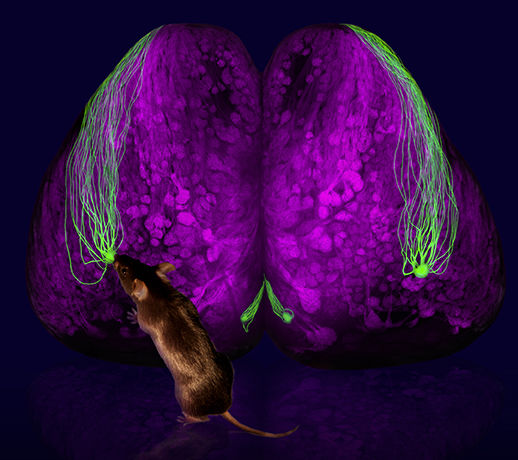
Olfactory coding
Understanding sensory processing relies on exploring and establishing a principled relationship between the stimulus space, its neural representation, and perceptual quality. We tackle this challenge using experimental, computational and theoretical tools.

In our experiments, we interrogate the olfactory system of behaving mice at different levels using rapid wide-field and two-photon imaging, multi-unit electrophysiology, optogenetic pattern stimulation, and quantitative behaviors
Wide-field imaging of glomerular activity in response to an odor
Two-photon imaging of Mitral cell responses to Methyl Tiglate, Allyl Butyrate, Pinene, Benzaldehyde, Heptanal, 3-Heptanone,
(white = response to multiple odors)
To characterize olfactory perceptual space, we develop a behavioral approach to measure perceptual distances between odor pairs, using delayed-match-to-sample behavioral paradigm (Nakayama 2022). Individual odor identities are characterized by their positions in the perceptual odor space in relationship
to other odors.


Delayed-matched-to-sample behavioral paradigm: the perceptual distance is proportional the probability of the no-go responses on non-matched trials.
3D projection of reconstructed perceptual odor space for 8 monomolecular odors and 16 binary mixtures.
Based on the recently proposed primacy model for concentration invariant odor coding (Wilson-2017) and a few simplifying assumptions, we have developed a theoretical framework for mapping the odor input space to the response properties of olfactory receptors (Giaffar-2024).
The theory predicts specific relationships
between receptors fields of individual
receptor types (or glomeruli), the
statistical features of mitral/tufted
cell feedforward connectivity to
the cortex, processing of odor
mixtures, and structure of the
perceptual odor space.

Odor identities are defined by the sets of primary (the most sensitive) receptors {1,2,3} and {3,4,5}, which are represented as simplexes on the low dimensional manifold in the
space of the receptor affinities to different ligands.
Currently we are developing both experimental and computational approaches to verify assumptions and test predictions of the theory
Behavioral relevance of neuronal code features
The most powerful way to test a neural coding model is to validate that the hypothesized code can be read by higher brain areas where it leads to an observable behavioral output. To this end, we are developing experimental strategies to establish causal links between the neuronal code and animal behavior. Following our earlier work with single glomerulus stimulation (Smear-2013) we are developing a general approach to test the readability of the olfactory code using an optogenetic pattern stimulation system in behaving mice. In this paradigm,
mice are trained to recognize a specific spatial-temporal pattern of glomerulus activation. Through systematic perturbation of this pattern during measurements of the behavioral response to these perturbations, we investigate the role of different features of the code for animal behavior (Chong-2020).
The next step after dissecting the olfactory code a the glomerulus/receptor level is testing of neural coding models at the individual neuron level. This requires developing a different technology capable of individual neuron stimulation. In a collaborative project with the Shoham lab (Tech4Health, NYU), we are developing a system for 2-photon holographic optogenetic stimulation of multiple neurons deep in the brain of the behaving animal (Gill-2020).
Applied olfaction
When it comes to versatility, speed, and specificity in detecting volatile chemicals, biological olfactory systems far outperform all artificial chemical detection devices. As a result, the use of trained animals for chemical detection in fields such as homeland security, defense, healthcare, and agriculture has increased significantly. However, the use of animals in this capacity requires extensive training and behavior-based communication. We are developing an alternative strategy, reading olfactory information directly from the brain and capitalizing on the superior capability of the mammalian
olfactory system.

Bio-electronic nose:
We are developing a brain-machine
interface that captures neuronal signals
from an early stage of olfactory processing
in mice and used machine learning techniques to form a sensitive and selective chemical detector. We are placing grid electrode arrays on the surface of the olfactory bulb to record spatiotemporal distribution of local field potential and develop algorithms to decode identity and concentrations of the presented odors (Shor-2022).
Disease diagnostics:
Many illnesses are associated with a unique signature of body odorants, called an odorprint. Reliable identification and detection of disease-specific odorprints will present a path for its rapid and non-invasive diagnosis and enable a better understanding of the physiology of that disease. Modern analytical methods significantly lag behind some animals’ abilities to recognize disease-specific odorprints. We are developing methods to both detect and decipher disease-specific odorprints using a combination
of in-vivo glomerular
imaging methods,
gas chromatography
and machine learning
methods for data
analysis.
